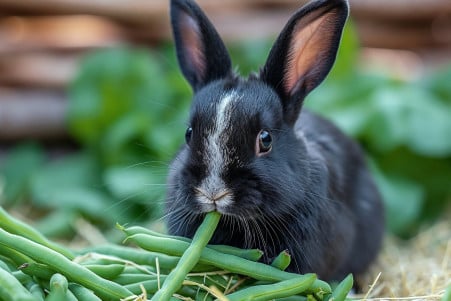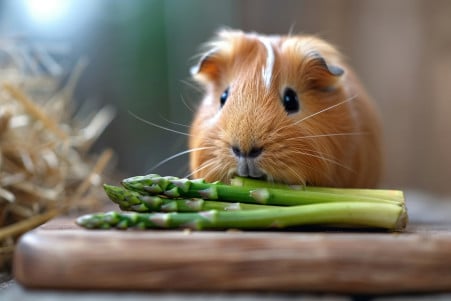Can Guinea Pigs Eat Green Beans? Nutritional Insights and Feeding Tips
8 February 2024 • Updated 8 February 2024

Looking to mix up your guinea pig’s diet with some green beans? Guinea pigs can eat green beans as part of a healthy diet. However, green beans should only be fed to guinea pigs as an occasional treat. When feeding your guinea pigs green beans, make sure they are fresh and raw, and cut them into small pieces to avoid choking and other digestive issues.
We will look at scientific research and expert opinions from veterinary nutrition and other animal care professionals to help us determine the role of green beans in a guinea pig’s diet. This will involve looking at research on their digestive physiology, nutrient needs, and how different foods impact their health.
After weighing the pros and cons, we hope to give you a better understanding of how to make sure your guinea pig is getting the right diet that will keep them healthy and happy.
Can guinea pigs eat green beans?
What Do Guinea Pigs Eat? The Basics of a Healthy Diet
Knowing what to feed guinea pigs is essential to their health. Supreme Petfoods notes that high-quality hay, such as meadow or Timothy hay, should make up around 80% of a guinea pig’s diet, and it should be the foundation of their diet. Not only does hay help with digestion, but it also helps with dental wear since guinea pigs’ teeth grow continuously.
Fresh vegetables are important for hydration and nutrients, and vitamin C is an important part of their diet that they can’t make themselves. VCA Animal Hospitals notes that a lack of vitamin C can cause health problems like scurvy, which can affect a guinea pig’s immune system and joints.
It’s also important to introduce new foods slowly because an unbalanced diet can cause digestive issues and other gastrointestinal problems.
The RSPCA says that guinea pigs should be given fresh, leafy greens that have been washed daily, and they note that guinea pigs have specific dietary requirements and that their diet shouldn’t be changed suddenly.
Vegetables are important for keeping guinea pigs hydrated and providing them with the vitamins they need, so they’re a critical part of their diet. Knowing this, you can better understand the importance of specific vegetables in a guinea pig’s diet and how they help ensure guinea pigs get the nutrients they need.
Green Beans: Nutritional Value for Guinea Pigs
Green beans are a human food staple and are full of vitamins and minerals that can be good for guinea pigs. According to Healthline, green beans are a low-calorie food that is high in vitamins A, C, and K and fiber. In fact, one cup of cooked green beans contains 4 grams of fiber, which is important for guinea pigs’ digestive health. Fiber helps keep the digestive system moving and can prevent constipation.
Green beans also contain carotenoids and flavonoids, which are antioxidants that can help lower the risk of chronic diseases and promote health, according to Everyday Health. These antioxidants help protect cells from damage, which is important for your pet’s health.
In addition, the high vitamin C content in green beans can help prevent scurvy, which is a real concern for guinea pigs since they need to get this vitamin from their diet and can’t produce it on their own.
According to Medical News Today, the low-calorie content of green beans and their support of bone health through calcium and vitamin K make them a good fit for guinea pig nutrition. Adding green beans to their diet can help ensure that they get the vitamins and minerals they need in a well-rounded way.
How to Add Green Beans to Your Guinea Pig’s Diet
When adding green beans to your guinea pig’s diet, it’s important to do so in a way that makes the experience as positive as possible for your pet.
According to Precisely Pets, you should start by giving your guinea pig a small amount, such as one green bean, and then monitor them for any negative reactions.
If your guinea pig doesn’t seem to have any digestive issues, like bloating or diarrhea, you can then increase the amount. Pet Keen suggests that you continue to feed green beans as an occasional treat, giving them to your pet one to three times a week.
In all cases, it’s important to make sure that the green beans you’re feeding your guinea pig are fresh and raw. As both sources note, canned and processed green beans are often full of preservatives and have high levels of sodium, both of which can be harmful to your guinea pig.
By feeding your pet fresh green beans, you’ll not only give them the crunch they love but also make sure that they’re getting all of the nutritional benefits, including fiber and vitamin C.
It’s also important to watch your guinea pig for signs of indigestion. After you’ve introduced green beans into their diet, make sure to monitor them for any changes in their stool or any signs of discomfort, as these can be signs of an intolerance or allergy.
It’s also important to note that while many guinea pigs will eventually enjoy the taste of fresh green beans, individual tastes can vary, and some guinea pigs may take longer to warm up to the new food.
That’s why it’s a good idea to offer a variety of vegetables in addition to green beans, as this will help ensure that your guinea pig is getting a well-rounded diet and may also help you determine if your pet has any specific dislikes or sensitivities.
Where Green Beans Fit Into a Guinea Pig’s Diet
In terms of other vegetables, green beans are a great source of vitamin C, which is one of the most important nutrients for guinea pigs. According to A-Z Animals, other vegetables that are high in vitamin C include bell peppers, spinach, broccoli, and cilantro.
Because guinea pigs can’t synthesize their own vitamin C, they need to get it from their diet. This makes green beans a great option, as they are similar to these other vegetables in terms of their vitamin C content but don’t have the same potential for bladder stones as spinach.
According to GuineaPiggles, while green beans are a good option for guinea pigs, not all vegetables are created equal. For example, cruciferous vegetables like cabbage and Brussels sprouts are nutritious but can cause gas, so they should be fed in moderation. On the other hand, green beans don’t have this effect, so they can be fed more regularly.
It’s also important to avoid feeding guinea pigs vegetables that are toxic to them, like the leaves of a tomato plant, which are poisonous.
By being selective about the vegetables you feed your guinea pig, you can ensure they get a well-rounded diet that includes a variety of nutrients. Green beans are a great option for this, as they are safe and nutritious and provide variety and important nutrients without the risk of toxicity or digestive upset.
Final Thoughts: Can Guinea Pigs Eat Green Beans?
To sum up, green beans seem like a good option for guinea pigs as long as they are fed in moderation and prepared properly. Not only do these crunchy vegetables provide guinea pigs with a fun treat, but they also offer important nutrients such as vitamins A, C, K, and dietary fiber.
Compared to other vegetables that are often fed to guinea pigs, green beans seem to be a good option that can help improve health without the risk of toxicity.
That said, the key to feeding green beans to guinea pigs is to make sure you do so in moderation and that you only feed them raw and fresh. It’s also important to introduce green beans to your guinea pig’s diet slowly to avoid digestive upset. As with any dietary change, it’s important to do your own research and talk to your vet to get personalized advice that meets your guinea pig’s specific needs.
A well-balanced diet is essential to guinea pig health and well-being. By adding green beans to a varied diet, you can help ensure that your guinea pig has the balanced diet that they need to live a long, healthy life.


